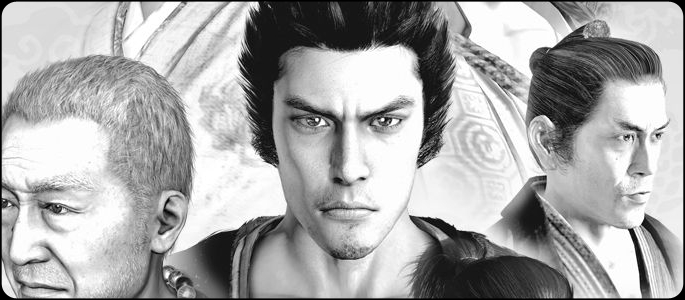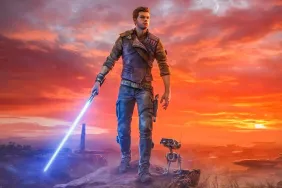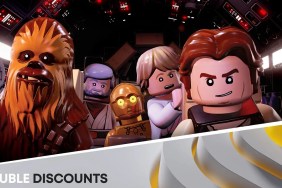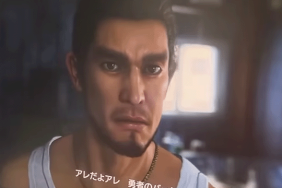In between the PS2’s Yakuza 2 (or Ryu Ga Gotoku 2, as the Yakuza series carries a different name in Japan) and PS3’s Yakuza 3 came a spinoff called Yakuza: Kenzan, the first of the series to actually make the leap into the current generation. Instead of taking to the streets of Tokyo as a tough, take-no-crap Japanese mobster, players of Kenzan take to the streets as a tough, take-no-crap Samurai. Gameplay is in many ways similar to that of other games in this series, but there are some huge atmospheric differences, as the game is set some 400 years ago in Japan’s Tokugawa era. Not only that, players will find themselves smack in the middle of a hat-tip to the life and legacy of Miyamoto Musashi.
Story is where Kenzan really shines, especially to Samurai nerds and fans of Eiji Yoshikawa’s famous Samurai epic, Musashi (which I highly recommend). The game takes a lot of the lore surrounding Miyamoto Musashi and puts a Yakuza spin on it, with Kazuma Kiryu playing the role of Musashi. It doesn’t end there, as other familiar faces from the series will show up as well, once again filling parts critical in Musashi’s tale. The giddiness this game provides those who love the Musashi story as well as the Ryu Ga Gotoku game series is off the freaking charts. I eventually stopped counting the number of times a huge smile spread across my face through the course of Kenzan.
There are some differences between this story and that told by Yoshikawa, not limited to each containing material the other does not. The way Sega turns things around and make the legend its own story is interesting and highly satisfying. To describe one example without spoiling anything in the book or game, a big pivotal moment for Musashi is when he changes his name from Takezou to Musashi in the first place, at the suggestion of his mentor at the time. In Yakuza: Kenzan, it’s altered so that a man already named Musashi looks to change his name due to social circumstances. After some consideration and a friendly suggestion, he changes it to…Kiryu. Kiryu Kazumanosuke, to be exact. Well played.
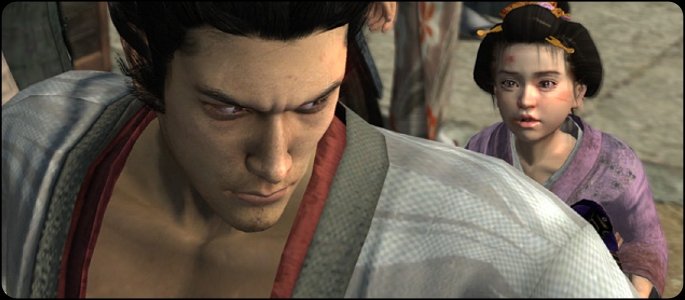
Another example that happens somewhat early on is Musashi’s (Kiryu’s) battle with Shishido Baiken. In the book, this unfolds much, much differently — like night and day, really. But then you see which popular Yakuza series character is playing the part of Shishido and you can help but enjoy yourself in the boss battle.
Yakuza: Kenzan‘s take on this legend begins with Musashi — now known as Kiryu — loafing about doing odd jobs, when a pre-teen girl named Haruka approaches him and puts a bounty on the head of one Miyamoto Musashi. This confuses him, because as we’ve established, he IS Miyamoto Musashi, so some clown is going around ruining his good name. This girl claims her whole family was killed by Musashi and says she’ll do whatever it takes to pay for his assassination. Kiryu wants no part of it, but he changes his mind when he sees the lengths this child is willing to go to in order to make this happen. He witnesses the girl approach the head of a local brothel and demand “Please buy me! Please!” Kiryu can barely stomach it and agrees to help her, for the one single gold piece she can provide. From there, it launches into the historical fiction/Yakuza hybrid described above.
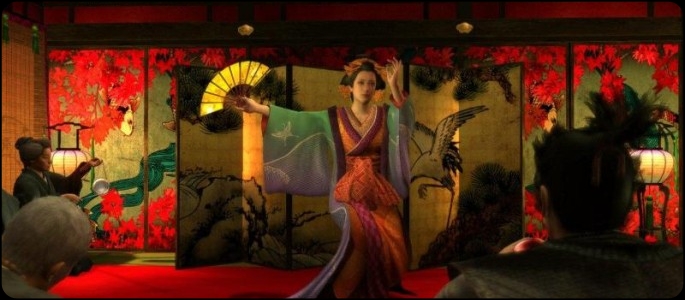
On the whole, Kenzan‘s world not as immersive as Yakuza 3 or 4. The 1605 town of Gion (a district of Kyoto) is considerably smaller and less populated than Kanurocho, the fictional district of modern Tokyo which the other Yakuza games call home. Being smaller isn’t bad necessarily, but it feels like there’s a little bit less to do as well. Less quests, less places to go, less immersion in general. There seem to be a lot more closed doors and other barriers. There are still a number of side stories to get involved with, but however many there are, it feels like there are less of them than in other Yakuza titles. If you’re coming off of Yakuza 3 or 4 and looking for another huge, open world to lose yourself in, this probably isn’t the game to satisfy that end.
Combat, like a couple other aspects of Kenzan, falls short of its series members and generational peers. Get ready for more than your fill of “Hwuh, hwuh, HWAH! Hwuh, hwuh, HWAH!” You’ll be making a whole heck of a lot of the same three-and-four-hit combos all game long. More special techniques and heat actions show up eventually, but they never take away from the dull, ultra-repetitious fighting. Other games in the series, including the most recent Yakuza 4, have included some amount of repetition in their combat, but in Kenzan, it’s clear that the fighting system was even more of an afterthought. What’s also annoying is that any hit — any at all — seems to send Musashi/Kiryu to the ground, be it a barehanded strike, sword swipe or otherwise. He’ll get knocked down and stay on the ground for what feels like 40 minutes then gingerly take to his feet again. It gets more annoying when fighting large groups that include the sumo wrestlers who can…somehow block sword slashes with their bare arms? Extra annoyance is added when the player is simply trying to get across town, and there’s fight…after fight…after fight that one is hard-pressed to just ignore, because the alleyways are so small and crowded that running from combat is usually not an option. One on hand, it’s understandable, since the biggest draws are its story and setting, but on the other hand, Miyamoto Musashi got famous through his legendary fighting.
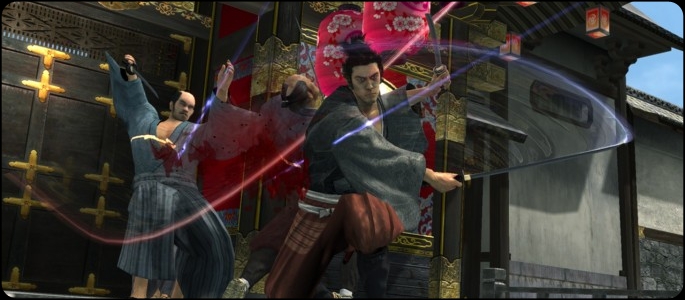
The more Kiryu does fight, the more his level will increase, though there’s less customization that fans of more recent Yakuza titles might be used to. In this game, the player does not choose how to spend experience points, but instead, the game simply informs the player “Level up!” and presents a list of attributes which improved. This, the combat, smaller town, and lower amount of quests make it clear that the story and atmosphere are the real focus of Ryu Ga Gotoku: Kenzan.
Kenzan looks like a lot of early PS3 titles overall, and bears striking resemblance to Yakuza 3, no doubt out of developer convenience. The way it captures the visual representation of a bustling Samurai-era town pretty good, and the atmosphere is created pretty well and if nothing else, facial expressions are handled nicely. Despite being a little bit behind the curve of graphical juggernauts like Uncharted 2 or artistic masterpieces like Valkyria Chronicles, the graphics are, at least, never a problem in the game. They do well enough and don’t detract from the experience. The soundtrack similarly serves its purpose without being either extreme of horrible or outstanding.
Having been a Japanese release in early 2008 and hitting the PS3’s “The Best” (Japan’s version of Greatest Hits) in December of that year but never getting a sniff of foreign release, it doesn’t look likely that this will be officially translated, so playing it means doing so in Japanese. To do so, prospective importers will need to sharpen both their written and spoken Japanese, as the game splits time between fully voiced sequences and unvoiced, text-only sequences that are heavy on the kanji. To a point, one might try to limp along without understanding the story, just following the radar blips, but that won’t work, as there are instances in which Kiryu must go somewhere else and fulfill another objective that is not guided by the radar, before advancing the story. So some extent of Japanese comprehension is absolutely required for this game. The voice-acted sequences are neither skippable nor pauseable, so you can’t hear Kiryu say “情報は力だろう?” and then pause the game and be all like “Crap, I gotta look that up. What’d he say? Jouhou?” Fortunately for some importers, there are also many sequences in which feature spoken dialogue to go with the subtitles, but it’s moved along by button presses. In these sequences, those needing to reach for the dictionary can take the time to do so and solidify their understanding of the story. With about an intermediate level of Japanese, you can hobble along through Kenzan. I say this meaning an actual intermediate level, not just having been exposed to classroom Japanese, as this game, like any other, uses plenty of colloquial speak and informal forms of words.
Yakuza: Kenzan is worth a playthrough for any fan of Miyamoto Musashi’s legend, especially so if you’re also a fan of Sega’s Yakuza games. However, take your search elsewhere if you’re looking to play this game for an adrenaline rush in combat or an exploration experience on par with other titles in the Yakuza series, or sandbox titles like Grand Theft Auto or The Elder Scrolls. Without being really into the subject matter, the gameplay would be kinda hard to get into and a little flat, especially if the language is a problem. For those up to the challenge and with an interest in old Japan, however, this comes recommended, as I had a blast.
PlayStation LifeStyle’s Final Score
– Combat leaves something to be desired +/- Familiarity with the Japanese language necessary |
 |
–
